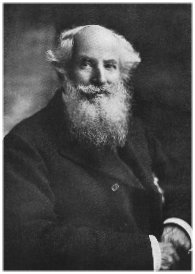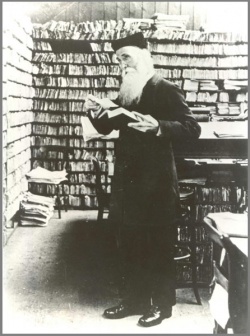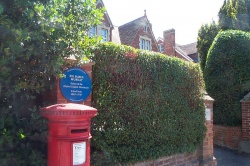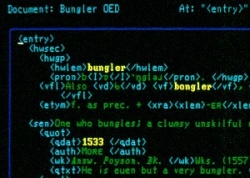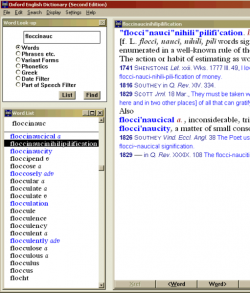Oxford English Dictionary
From Textus Receptus
(→Further reading) |
m (Protected "Oxford English Dictionary" [edit=autoconfirmed:move=autoconfirmed]) |
Revision as of 22:56, 29 January 2010
The Oxford English Dictionary (OED), published by the Oxford University Press, is a comprehensive dictionary of the English language.[2] Two fully-bound print editions of the OED have been published under its current name, in 1928 and 1989. As of December 2008[update], the editors had completed one quarter of a third edition.[3]
Contents |
History
Origins
At first, the dictionary was unconnected to Oxford University but was the idea of a small group of intellectuals in London;[6] it originally was a Philological Society project conceived in London by Richard Chenevix Trench, Herbert Coleridge, and Frederick Furnivall, who were dissatisfied with the current English dictionaries. In June 1857, they formed an "Unregistered Words Committee" to search for unlisted and undefined words lacking in current dictionaries. In November, Trench's report was not a list of unregistered words; instead, it was the study On Some Deficiencies in our English Dictionaries, which identified seven distinct shortcomings in contemporary dictionaries:
- Incomplete coverage of obsolete words
- Inconsistent coverage of families of related words
- Incorrect dates for earliest use of words
- History of obsolete senses of words often omitted
- Inadequate distinction among synonyms
- Insufficient use of good illustrative quotations
- Space wasted on inappropriate or redundant content.
The Philological Society, however, ultimately realized that the number of unlisted words would be far more than the number of words in the English dictionaries of the 19th century. The Society eventually shifted their idea from only words that were not already in English dictionaries to a more comprehensive project. Trench suggested that a new, truly comprehensive dictionary was needed. On January 7, 1858, the Society formally adopted the idea of a comprehensive new dictionary.[7] Volunteer readers would be assigned books and copy to quotation slips passages illustrating actual word usages, then post them to the dictionary editor. In 1858, the Society agreed to the project in principle, with the title "A New English Dictionary on Historical Principles" (NED).
Early editors
Richard Chenevix Trench played the key role in the project's first months, but his ecclesiastical career meant that he could not give the dictionary project the time required, easily ten years[citation needed]; he withdrew, and Herbert Coleridge became the first editor.
On 12 May 1860, Coleridge's dictionary plan was published, and research started. His house was the first editorial office. He arrayed 100,000 quotation slips in a 54-pigeon-hole grid. In April 1861, the group published the first sample pages; later that month, the thirty-one-year old Coleridge died of tuberculosis.
Furnivall then became editor; he was enthusiastic and knowledgeable, yet temperamentally ill-suited for the work.[8] Many volunteer readers eventually lost interest in the project as Furnivall failed to keep them motivated. Furthermore, many of the slips had been misplaced.
Recruited assistants handled two tons of quotation slips and other materials. Furnivall understood the need for an efficient excerpting system, and instituted several prefatory projects. In 1864, he founded the Early English Text Society, and in 1868, he founded the Chaucer Society for preparing general benefit editions of immediate value to the dictionary project. The compilation lasted 21 years.[citation needed] In the 1870s, Furnivall unsuccessfully attempted to recruit both Henry Sweet and Henry Nicol to succeed him. He then approached James Murray, who accepted the post of editor. In the late 1870s, Furnivall and Murray met with several publishers about publishing the dictionary. In 1878, Oxford University Press agreed with Murray to proceed with the massive project; the agreement was formalized the following year.[9] The dictionary project finally had a publisher 20 years after the idea was conceived. It would be another 50 years before the entire dictionary was complete.
Despite the participation of some 800 volunteer readers, the technology of paper-and-ink was the major drawback regarding the arbitrary choices of relatively untrained volunteers about "what to read and select" and "what to discard."[cite this quote][clarification needed]
Late during his editorship of the dictionary Murray learned that a prolific contributor to it, W. C. Minor, was in fact an inmate of the Broadmoor Asylum for the Criminally Insane.[10] Minor was a Yale University trained surgeon and military officer in the U.S. Civil War who had been sent to the asylum after murdering a man in London. The stories of Murray and Minor became the main subjects of a bestselling book written by Simon Winchester, published in the United States as The Professor and the Madman: A Tale of Murder, Insanity, and the Making of the Oxford English Dictionary[11] and in other countries as The Surgeon of Crowthorne: a tale of murder, madness and the love of words.
Oxford editors
During the 1870s, the Philological Society was concerned with the process of publishing a dictionary with such an immense scope. Although they had pages printed by publishers, no publication agreement was reached; both the Cambridge University Press and the Oxford University Press were approached. Finally, in 1879, after two years' negotiating by Sweet, Furnivall, and Murray, the OUP agreed to publish the dictionary and to pay the editor, Murray, who was also the Philological Society president. The dictionary was to be published as interval fascicles, with the final form in four 6,400-page volumes. They hoped to finish the project in ten years.
Murray started the project, working in a corrugated iron outbuilding, the "Scriptorium", which was lined with wooden planks, book shelves, and 1,029 pigeon-holes for the quotation slips. He tracked and regathered Furnivall's collection of quotation slips, which were found to concentrate on rare, interesting words rather than common usages: for instance, there were ten times more quotations for abusion than for abuse.[citation needed] He appealed for readers in newspapers distributed to bookshops and libraries; readers were specifically asked to report "as many quotations as you can for ordinary words" and for words that were "rare, obsolete, old-fashioned, new, peculiar or used in a peculiar way."[cite this quote] Murray had American philologist and liberal-arts-college professor Francis March manage the collection in North America; 1,000 quotation slips arrived daily to the Scriptorium, and by 1882, there were 3,500,000.
The first Dictionary fascicle was published on 1 February 1884—-twenty-three years after Coleridge's sample pages. The full title was A New English Dictionary on Historical Principles; Founded Mainly on the Materials Collected by The Philological Society; the 352-page volume, words from A to Ant, cost 12s.6d or U.S.$3.25. The total sales were a disappointing 4,000 copies.[citation needed]
The OUP saw it would take too long to complete the work with unrevised editorial arrangements. Accordingly, new assistants were hired and two new demands were made on Murray. The first was that he move from Mill Hill to Oxford; he did, in 1885. Murray had his Scriptorium re-erected on his new property.
Murray resisted the second demand: that if he could not meet schedule, he must hire a second, senior editor to work in parallel to him, outside his supervision, on words from elsewhere in the alphabet. Murray did not want to share the work, feeling he would accelerate his work pace with experience.[citation needed] That turned out not to be so, and Philip Gell of the OUP forced the promotion of Murray's assistant Henry Bradley (hired by Murray in 1884), who worked independently in the British Museum in London, beginning in 1888. In 1896, Bradley moved to Oxford University. Famously, Dr. W. C. Minor was a prolific contributor as a reader for Murray. Whilst imprisoned in a criminal lunatic asylum, he invented his own quotation-tracking system, so that he could then submit his slips upon the editors' request.
Gell continued harassing Murray and Bradley with his business concerns—containing costs and speedy production—to the point where the project's collapse seemed likely. Newspapers[specify] reported the harassment, and public opinion backed the editors. Gell was fired, and the University reversed his cost policies. If the editors felt that the Dictionary would have to grow larger, it would; it was an important work, and worth the time and money to properly finish. Neither Murray nor Bradley lived to see it. Murray died in 1915, having been responsible for words starting with A-D, H-K, O-P and T, nearly half the finished dictionary; Bradley died in 1923, having completed E-G, L-M, S-Sh, St and W-We. By then two additional editors had been promoted from assistant work to independent work, continuing without much trouble. William Craigie, starting in 1901, was responsible for N, Q-R, Si-Sq, U-V and Wo-Wy. Whereas previously the OUP had thought London too far from Oxford, after 1925 Craigie worked on the dictionary in Chicago, where he was a professor. The fourth editor was C. T. Onions, who, starting in 1914, compiled the remaining ranges, Su-Sz, Wh-Wo and X-Z. It was around this time that J. R. R. Tolkien was employed by the OED, researching etymologies of the Waggle to Warlock range [12]; he parodied the principal editors as "The Four Wise Clerks of Oxenford" in the story Farmer Giles of Ham. Julian Barnes also was an employee; he was said[who?] to dislike the work.
Fascicles
By early 1894 a total of 11 fascicles had been published, or about one per year: four for A-B, five for C, and two for E. Of these, eight were 352 pages long, while the last one in each group was shorter to end at the letter break (which would eventually become a volume break). At this point it was decided to publish the work in smaller and more frequent instalments: once every three months, beginning in 1895, there would now be a fascicle of 64 pages, priced at 2s.6d. or $1 U.S. If enough material was ready, 128 or even 192 pages would be published together. This pace was maintained until World War I forced reductions in staff. Each time enough consecutive pages were available, the same material was also published in the original larger fascicles.
Also in 1895, the title Oxford English Dictionary (OED) was first used. It then appeared only on the outer covers of the fascicles; the original title was still the official one and was used everywhere else. The 125th and last fascicle, covering words from Wise to the end of W, was published on 19 April 1928, and the full Dictionary in bound volumes followed immediately.
The early modern English prose of Sir Thomas Browne is probably the most frequently quoted source of neologisms in the completed dictionary. William Shakespeare is the most-quoted writer, with Hamlet his most-quoted work. George Eliot (Mary Ann Evans) is the most-quoted woman writer. Collectively, the Bible is the most-quoted work (but in many different translations); the most-quoted single work is Cursor Mundi.
Oxford English Dictionary and First Supplement
Between 1928 and 1933 enough additional material had been compiled to make a one volume supplement so the dictionary was reissued as the set of 12 volumes and a one-volume supplement in 1933.
Second Supplement and Second Edition
In 1933 Oxford University had finally put the Dictionary to rest; all work ended, and the quotation slips went into storage. However, the English language continued to change, and by the time 20 years had passed, the Dictionary was outdated.
There were three possible ways to update it. The cheapest would have been to leave the existing work alone and simply compile a new supplement of perhaps one or two volumes; but then anyone looking for a word or sense and unsure of its age would have to look in three different places. The most convenient choice for the user would have been for the entire dictionary to be re-edited and retypeset, with each change included in its proper alphabetical place; but this would have been the most expensive option, with perhaps 15 volumes required to be produced. The OUP chose a middle approach: combining the new material with the existing supplement to form a larger replacement supplement.
Robert Burchfield was hired in 1957 to edit the second supplement; Onions, who turned 84 that year, was still able to make some contributions as well. Burchfield emphasized the inclusion of modern-day language, and through the supplement the dictionary was expanded to include a wealth of new words from the burgeoning fields of science and technology, as well as popular culture and colloquial speech. Burchfield also broadened the scope to include developments of the language in English-speaking regions beyond the United Kingdom, including North America, Australia, New Zealand, South Africa, India, Pakistan, and the Caribbean. The work was expected to take seven to ten years.[citation needed] It actually took 29 years, by which time the new supplement (OEDS) had grown to four volumes, starting with A, H, O and Sea. They were published in 1972, 1976, 1982, and 1986 respectively, bringing the complete dictionary to 16 volumes, or 17 counting the first supplement.
By this time it was clear that the full text of the Dictionary would now need to be computerized. Achieving this would require retyping it once, but thereafter it would always be accessible for computer searching — as well as for whatever new editions of the dictionary might be desired, starting with an integration of the supplementary volumes and the main text. Preparation for this process began in 1983, and editorial work started the following year under the administrative direction of Timothy J. Benbow, with John A. Simpson and Edmund S. C. Weiner as co-editors.
And so the New Oxford English Dictionary (NOED) project began. More than 120 keyboarders of the International Computaprint Corporation in Tampa, Florida, and Fort Washington, Pennsylvania, USA, started keying in over 350,000,000 characters, their work checked by 55 proof-readers in England. Retyping the text alone was not sufficient; all the information represented by the complex typography of the original dictionary had to be retained, which was done by marking up the content in SGML. A specialized search engine and display software were also needed to access it. Under a 1985 agreement, some of this software work was done at the University of Waterloo, Canada, at the Centre for the New Oxford English Dictionary, led by Frank Tompa and Gaston Gonnet; this search technology went on to become the basis for the Open Text Corporation. Computer hardware, database and other software, development managers, and programmers for the project were donated by the British subsidiary of IBM; the colour syntax-directed editor for the project, LEXX, was written by Mike Cowlishaw of IBM.[13] The University of Waterloo, in Canada, volunteered to design the database. A. Walton Litz, an English professor at Princeton University who served on the Oxford University Press advisory council, was quoted in Time as saying "I've never been associated with a project, I've never even heard of a project, that was so incredibly complicated and that met every deadline."[14]
By 1989 the NOED project had achieved its primary goals, and the editors, working online, had successfully combined the original text, Burchfield's supplement, and a small amount of newer material, into a single unified dictionary. The word "new" was again dropped from the name, and the Second Edition of the OED, or the OED2, was published. The first edition retronymically became the OED1.
The OED2 was printed in 20 volumes. For the first time, there was no attempt to start them on letter boundaries, and they were made roughly equal in size. The 20 volumes started with A, B.B.C., Cham, Creel, Dvandva, Follow, Hat, Interval, Look, Moul, Ow, Poise, Quemadero, Rob, Ser, Soot, Su, Thru, Unemancipated, and Wave.
Although the content of the OED2 is mostly just a reorganization of the earlier corpus, the retypesetting provided an opportunity for two long-needed format changes. The headword of each entry was no longer capitalized, allowing the user to readily see those words that actually require a capital letter. Also, whereas Murray had devised his own notation for pronunciation, there being no standard available at the time, the OED2 adopted the modern International Phonetic Alphabet. Unlike the earlier edition, all foreign alphabets except Greek were transliterated.
The British quiz show Countdown has awarded the leather-bound complete version to the champions of each series since its inception in 1982.
When the print version of the second edition was published in 1989, the response was enthusiastic. The author Anthony Burgess declared it "the greatest publishing event of the century," as quoted by Dan Fisher of the Los Angeles Times (25 March 1989).[cite this quote] TIME dubbed the book "a scholarly Everest,"[14] and Richard Boston, writing for the London Guardian (24 March 1989), called it "one of the wonders of the world."[cite this quote]
New material was published in the Oxford English Dictionary Additions Series, which consisted of two small volumes in 1993, and a third in 1997, bringing the dictionary to a total of 23 volumes. Each of the supplements added about 3,000 new definitions. However, no more Additions volumes are planned, and it is not expected that any part of the Third Edition, or OED3, will be printed in fascicles.
Compact editions
In 1971, the 13-volume OED1 (1933) was reprinted as a two-volume, Compact Edition, done by photographically reducing each page to one-half its linear dimensions; each compact edition page held four OED1 pages in a four-up ("4-up") format. The two volume letters were A and P; the Supplement was at the second volume's end.
The Compact Edition included, in a small slip-case drawer, a magnifying glass to help in reading reduced type. Many copies were inexpensively distributed through book clubs. In 1987, the second Supplement was published as a third volume to the Compact Edition. In 1991, for the OED2, the compact edition format was re-sized to one-third of original linear dimensions, a nine-up ("9-up") format requiring greater magnification, but allowing publication of a single-volume dictionary. It was accompanied by a magnifying glass as before and A User's Guide to the "Oxford English Dictionary", by Donna Lee Berg. After these volumes were published, though, book club offers commonly continued to sell the two-volume 1971 Compact Edition.
Electronic versions
Once the text of the dictionary was digitized and online, it was also available to be published on CD-ROM. The text of the First Edition was made available in 1988. Afterward, three versions of the second edition were issued. Version 1 (1992) was identical in content to the printed Second Edition, and the CD itself was not copy-protected. Version 2 (1999) had some additions to the corpus, and updated software with improved searching features, but it had clumsy copy-protection that made it difficult to use and would even cause the program to deny use to OUP staff in the midst of demonstrating the product[citation needed]. Version 3 was released in 2002 with additional words and software improvements, though its copy-protection remained as unforgiving as that of the earlier version.
The current and only edition of the OED on CD available for purchase from Oxford University Press, Version 3.1.1 (2007), includes a return to the less restrictive nature of Version 1, with support for hard disk installation, so that the user does not have to insert the CD to use the dictionary. It has been reported[15][16] that this version will work on operating systems other than Microsoft Windows, using emulation programs.
Version 4.0 of the CD, available since June 2009, works with Windows 7 and, for the first time ever, with Mac OS X (10.4 or better).[17][18] This version will use the CD drive for installation, running only from the hard drive.
On 14 March 2000, the Oxford English Dictionary Online (OED Online) became available to subscribers.[19] The online database contains the entire OED2 and is updated quarterly with revisions that will be included in the OED3 (see below). The online edition is the most up-to-date version of the dictionary available.
Whilst the OED web site is not optimised for mobile devices, they have stated that there are plans to provide an API[20] which would enable developers to develop different interfaces for querying the OED.
As the price for an individual to use this edition, even after a reduction in 2004, is £195 or $295 US every year, most subscribers are large organizations such as universities. Some of them[citation needed] do not use the Oxford English Dictionary Online portal and have legally downloaded the entire database into their organization's computers. Some public libraries and companies have subscribed as well, including, in March and April 2006, most public libraries in England and Wales[21] and New Zealand;[22][23] any person belonging to a library subscribing to the service is able to use the service from their own home.
Another method of payment was also introduced in 2004, offering residents of North or South America the opportunity to pay $29.95 US a month to access the online site.
Third Edition
The planned Third Edition, or OED3, is intended as a nearly complete overhaul of the work. Each word is being examined and revised to improve the accuracy of the definitions, derivations, pronunciations, and historical quotations—a task requiring the efforts of a staff consisting of more than 300 scholars, researchers, readers, and consultants, and projected to cost about $55 million. The result is expected to double the overall length of the text. The style of the dictionary will also change slightly. The original text was more literary, in that most of the quotations were taken from novels, plays, and other literary sources. The new edition, however, will reference all manner of printed resources, such as cookbooks, wills, technical manuals, specialist journals, and rock lyrics. The pace of inclusion of new words has been increased to the rate of about 4,000 a year. The estimated date of completion is 2037.[24][25]
New content can be viewed through the OED Online or on the periodically updated CD-ROM edition.
As of 1993, John Simpson is the Chief Editor. Since the first work by each editor tends to require more revision than his later, more polished work, (work on the first edition was begun at A) it was decided to balance out this effect, by performing the early, and perhaps itself less polished, work of the current revision at a letter other than A. Accordingly, the main work of the OED3 has been proceeding in sequence from the letter M. When the OED Online was launched in March 2000, it included the first batch of revised entries (officially described as draft entries), stretching from M to mahurat, and successive sections of text have since been released on a quarterly basis; by September 2009, the revised section had reached refulgent. As new work is done on words in other parts of the alphabet, this is also included in each quarterly release. In March 2008, the editors announced that they would alternate each quarter between moving forward in the alphabet as before and updating "key English words from across the alphabet, along with the other words which make up the alphabetical cluster surrounding them."
The production of the new edition takes full advantage of computers, particularly since the June 2005 inauguration of the whimsically named "Perfect All-Singing All-Dancing Editorial and Notation Application", or "Pasadena." With this XML-based system, the attention of lexicographers can be directed more to matters of content than to presentation issues such as the numbering of definitions. The new system has also simplified the use of the quotations database, and enabled staff in New York to work directly on the Dictionary in the same way as their Oxford-based counterparts.[26]
Other important computer uses include internet searches for evidence of current usage, and e-mail submissions of quotations by readers and the general public.
Wordhunt was a 2005 appeal to the general public for help in providing citations for 50 selected recent words, and produced antedatings for many. The results were reported in a BBC TV series, Balderdash and Piffle. The OED’s small army of devoted readers continue to contribute quotations; the department currently receives about 200,000 a year.
For more article, see External Link below.
Notes
- 1. OED2 from Amazon.com
- 2. Oxford University Press
- 3. OED reaches its quarter mark from the official OED website
- 4. OED Facts
- 5. http://www.oed.com/news/updates/revisions0712.html
- 6. Winchester, Simon (1999). The Professor and the Madman. New York: HarperPernnial. pp. 103–104, 112. ISBN 0-06-083978-3.
- 7. Winchester, Simon (1999). The Professor and the Madman. New York: HarperPernnial. pp. 107–108. ISBN 0-06-083978-3.
- 8. Winchester, Simon (1999). The Professor and the Madman. New York: HarperPernnial. pp. 110. ISBN 0-06-083978-3.
- 9. Winchester, Simon (1999). The Professor and the Madman. New York: HarperPernnial. pp. 111–112. ISBN 0-06-083978-3.
- 10. Winchester, Simon (1999). The Professor and the Madman. New York: HarperPernnial. p. xiii. ISBN 0-06-083978-3.
- 11. Winchester, Simon (1999). The Professor and the Madman. New York: HarperPernnial. ISBN 0-06-083978-3.
- 12. OED Contributors: Tolkien
- 13. LEXX – A programmable structured editor, Cowlishaw, M. F., IBM Journal of Research and Development, Vol 31, No. 1, 1987, IBM Reprint order number G322-0151
- 14. Paul Gray, "A Scholarly Everest Gets Bigger," Time, March 27, 1989.
- 15. R.J.Holmgren, "v3.x under Mac OS X and Linux", last revised 22 March 2008. Accessed 19 April 2008
- 16. "Bernie" from ELearnAid.com, "Oxford English Dictionary News", 6 May 2004. Accessed 19 April 2008
- 17. "Oxford English Dictionary, 2nd Edition, Version 4.0 (Windows & Mac)". http://www.amazon.com/Oxford-English-Dictionary-Version-Windows/dp/0199563837/.
- 18. "Mac Compatibility". http://www.oup.co.uk/ep/cdroms/oed/oed2v3_11/#4.
- 19. Juliet New (22 March 2000). "'The world's greatest dictionary' goes online". Ariadne (23). ISSN 1361-3200. http://www.ariadne.ac.uk/issue23/oed-online/. Retrieved 2007-03-18. ,
- 20. "Looking Forward to an Oxford English Dictionary API". http://blog.webometrics.org.uk/2009/08/looking-forward-to-oxford-english.html.
- 21. "Oxford Online in English Public Libraries". http://www.oup.com/online/englishpubliclibraries/.
- 22. "New Zealand procurement". http://epic.org.nz/nl/Procurement.html.
- 23. "OED on-line New Zealand". http://epic.org.nz/nl/oup.html#oed.
- 24. Stephanie Willen Brown, From Unregistered Words to OED3, CogSci Librarian, 23 August 2007. Accessed 23 October 2007.
- 25. Simon Winchester. History of the Oxford English Dictionary TVOntario Big Ideas. (2007-05-27). Podcast accessed on 2007-12-01.
- 26. Liz Thompson (December 2005). "Pasadena: A Brand New System for the OED" (PDF). Oxford English Dictionary News (Oxford University Press): p. 4. http://oed.com/pdfs/oed-news-2005-12.pdf. Retrieved 2007-03-15.
- 27. http://www.askoxford.com/asktheexperts/faq/aboutspelling/ize?view=get
- 28. Harris 1982, p.935.
- 29. Globe & Mail
References
- Creaser, Wanda. Review of Willinsky, John, Empire of Words: The Reign of the Oxford English Dictionary. Rocky Mountain Review of Language and Literature 50:1 (1996): 108-109. JSTOR. 7 April 2008. [1]
- Harris, Roy (1982-09-03). "The History Men". Times Literary Supplement: 935–936.
- Gleick, James (2006-11-05). "Cyber-Neologoliferation". The New York Times Magazine.
Further reading
- Caught in the Web of Words: J. A. H. Murray and the Oxford English Dictionary, by K. M. Elisabeth Murray, Oxford University Press and Yale University Press, 1977; new edition 2001, Yale University Press, trade paperback, ISBN 0-300-08919-8.
- Empire of Words: The Reign of the Oxford English Dictionary, by John Willinsky, Princeton University Press, 1995, hardcover, ISBN 0-691-03719-1.
- The Meaning of Everything: The Story of the Oxford English Dictionary, Simon Winchester, Oxford University Press, 2003, hardcover, ISBN 0-19-860702-4.
- (UK title) The Surgeon of Crowthorne / (US title) The Professor and the Madman: A Tale of Murder, Insanity, and the Making of The Oxford English Dictionary, by Simon Winchester; see The Surgeon of Crowthorne for full details of the various editions.
- Lost for Words: The Hidden History of the Oxford English Dictionary, by Lynda Mugglestone, Yale University Press, 2005, hardcover, ISBN 0-300-10699-8.
- The Ring of Words: Tolkien and the Oxford English Dictionary, by Peter Gilliver, Jeremy Marshall, and Edmund Weiner, Oxford University Press, 2006, hardcover, ISBN 0-19-861069-6.
- Treasure-House of the Language: the Living OED, Charlotte Brewer, Yale University Press, 2007, hardcover, ISBN 978-0-300-12429-3.
- Chasing the Sun: Dictionary Makers and the Dictionaries They Made, by Jonathon Green, Jonathan Cape, 1996, hardcover, ISBN 0-224-04010-3.
External Link
- The Oxford English Dictionary's official website
- Archive of documents (as page images), including
- Trench's original "Deficiencies in our English Dictionaries" paper
- Murray's original appeal for readers
- Their page of OED statistics, and another such page.
- Two Template:PDFlink from the OED.
- Archive of documents (as page images), including
- Examining the OED: Charlotte Brewer's analysis of the principles and practices used by OED editors
- Bibliography of "[c]ritical assessments of OED or accounts of its history", from Examining the OED
- The OED Meets Cyberspace: James Gleick's 2006 article.
- The New English Dictionary on Historical Principles (OED-1). Volume Index or all volumes at Internet Archive
- Template:Cite podcast
